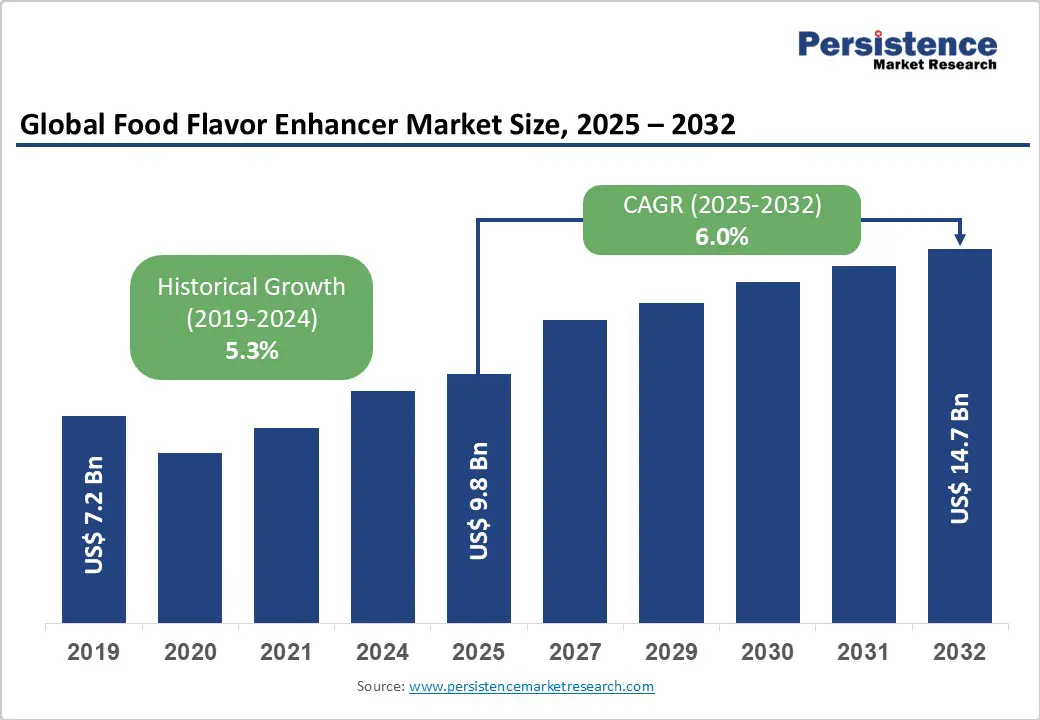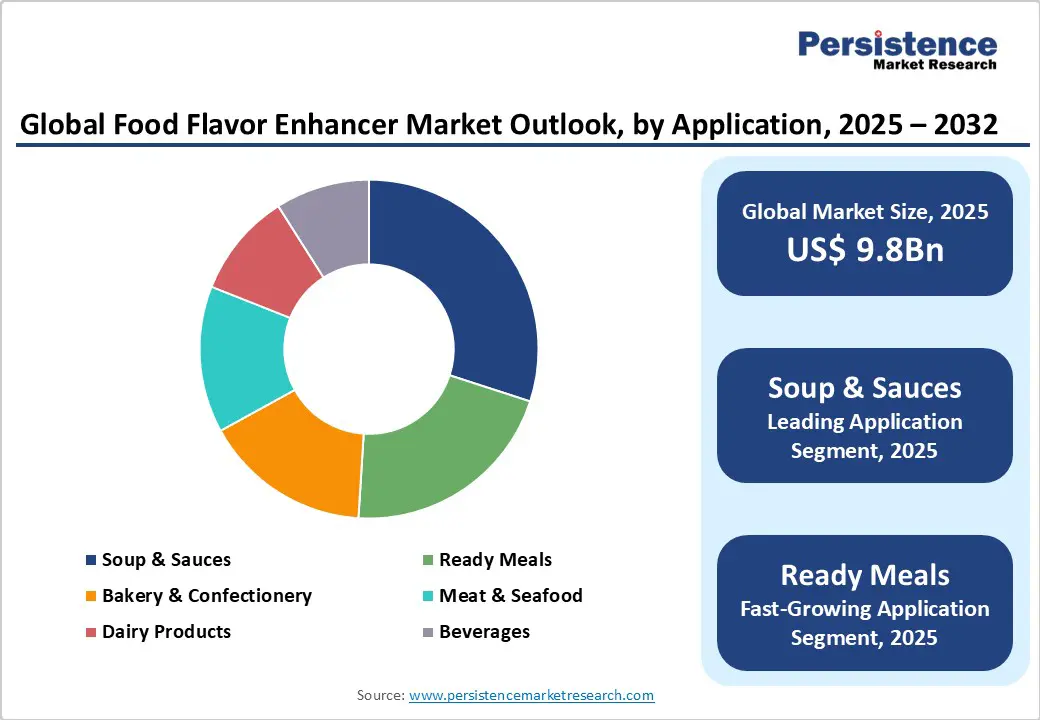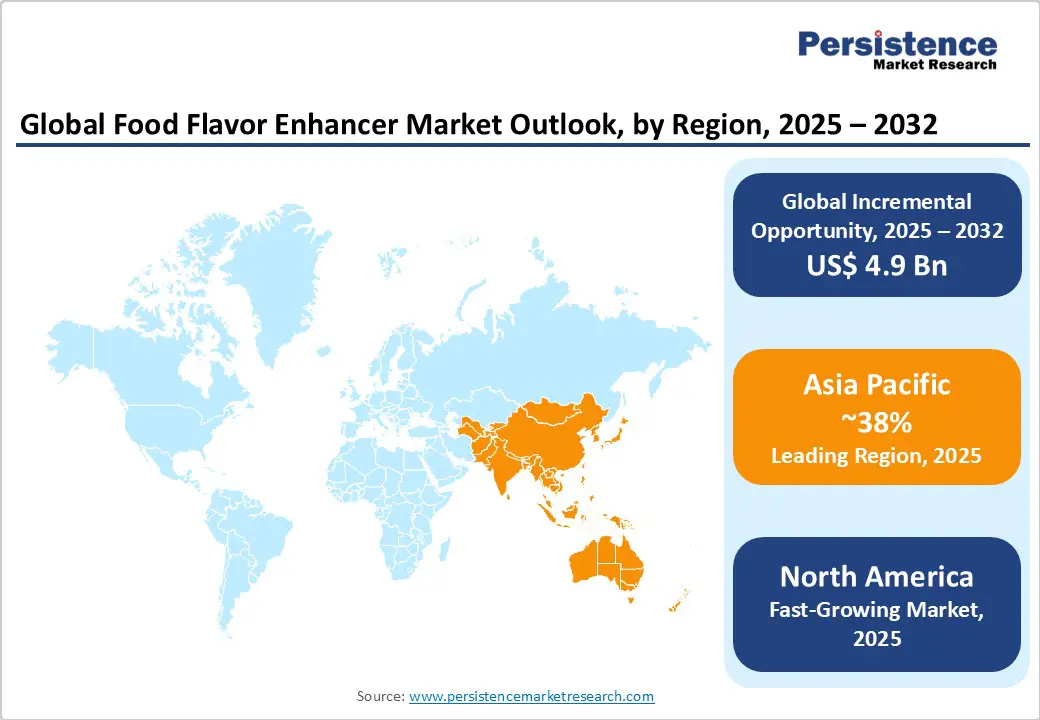ID: PMRREP31200| 200 Pages | 9 Oct 2025 | Format: PDF, Excel, PPT* | Food and Beverages

The global food flavor enhancer market size is likely to be valued at US$9.8 billion in 2025. It is expected to grow to US$14.7 billion by 2032, increasing at a CAGR of 6.0% during the forecast period from 2025 to 2032, driven by rising consumer demand for enhanced taste profiles, the growing popularity of processed and convenience foods, and advancements in flavor-enhancing technologies.
| Key Insights | Details |
|---|---|
|
Food Flavor Enhancer Market Size (2025E) |
US$ 9.8 Bn |
|
Market Value Forecast (2032F) |
US$14.7 Bn |
|
Projected Growth (CAGR 2025 to 2032) |
6.0% |
|
Historical Market Growth (CAGR 2019 to 2024) |
5.3% |

The rising demand for processed and convenience foods is a significant driver in the food flavor enhancer market. Modern lifestyles, characterized by busy work schedules, urbanization, and changing dietary habits, have created strong consumer reliance on ready-to-eat meals, packaged snacks, instant beverages, and frozen foods. These products often require the use of flavor enhancers to maintain taste, aroma, and texture during large-scale production and extended shelf life. Flavor enhancers such as monosodium glutamate (MSG), yeast extracts, and enzyme-based solutions play a critical role in ensuring that convenience foods meet consumer expectations for freshness and flavor consistency.
The growth of quick-service restaurants (QSRs), fast-food chains, and online food delivery platforms has amplified the demand for processed food products that deliver consistent taste across regions. For instance, global chains such as McDonald’s and KFC rely on flavor enhancers and standardized formulations to ensure that their burgers, fries, or chicken products taste the same whether served in the United States, Europe, or Asia. Furthermore, the rising middle-class population in emerging economies and increasing disposable incomes contribute to the surge in packaged food consumption. Collectively, these factors underline the importance of flavor enhancers, positioning them as indispensable in supporting the growing global appetite for convenient, affordable, and tasty food options.
Health concerns and stringent regulatory restrictions pose significant challenges to the Food Flavor Enhancer Market. Flavor enhancers such as monosodium glutamate (MSG), artificial sweeteners, and certain chemical additives have long been associated with potential health issues, including headaches, obesity, hypertension, and metabolic disorders. Although scientific evidence on some of these claims remains debated, growing consumer skepticism has reduced the acceptance of synthetic flavor enhancers in many regions. For instance, in the European Union, the use of certain artificial flavor enhancers such as aspartame is strictly regulated, requiring mandatory labeling and maximum permissible intake limits, while MSG-containing products must clearly declare the additive to ensure consumer transparency.
Regulatory authorities such as the U.S. Food and Drug Administration (FDA), the European Food Safety Authority (EFSA), and other global agencies have imposed stringent guidelines on the usage, labeling, and safety limits of flavor enhancers. In Europe, for example, any product containing additives must adhere to detailed ingredient transparency and allergen declarations, which can delay approvals and increase compliance costs for manufacturers. These health and regulatory challenges force companies to invest heavily in research, testing, and reformulation, which in turn raises production costs and slows down market growth.
Advancements in natural and plant-based flavor enhancers present a major opportunity for growth in the food flavor enhancer market. With increasing consumer demand for clean-label, chemical-free, and health-focused products, food manufacturers are shifting toward natural alternatives derived from herbs, spices, fruits, vegetables, and microbial fermentation.
These plant-based flavor enhancers not only improve taste and aroma but also align with consumer expectations for transparency, sustainability, and wellness. For instance, companies such as Givaudan and Kerry Group have launched natural flavor solutions derived from plant extracts and fermentation processes, enabling food manufacturers to replace synthetic enhancers such as MSG with clean-label alternatives that cater to health-conscious consumers. Similarly, botanical extracts such as rosemary, mushroom concentrates, and seaweed-derived enhancers are being integrated into snacks, soups, sauces, and meat substitutes to create more authentic flavor experiences. The rise of plant-based diets and the growing flexitarian population further boost this trend, as consumers seek flavorful, healthy, and environmentally friendly food options. Ongoing advancements in food biotechnology and enzyme-based extraction methods are enabling manufacturers to develop highly effective natural flavor enhancers at competitive costs. This shift not only opens new product innovation opportunities but also helps brands build stronger trust and differentiation in a competitive marketplace.
Glutamates dominate the Food Flavor Enhancer Market, expected to account for approximately 39% share in 2025. Their dominance is driven by their ability to enhance umami flavors, making them a staple in soups, sauces, and processed foods. Companies such as Ajinomoto Group and B&G Foods Inc. leverage glutamates for their cost-effectiveness and versatility, enabling seamless integration into large-scale food production.
The yeast extract segment is the fastest-growing, fueled by the rising demand for natural and clean-label ingredients. Yeast extracts, offered by companies such as Kerry Group and Scelta Mushrooms B.V., are increasingly used in plant-based and organic food products due to their natural origin and ability to enhance savory flavors. Their adoption in vegan and vegetarian products is accelerating growth, particularly in regions with high demand for sustainable food solutions.
Plant-based flavor enhancers lead, holding approximately 45% share in 2025. Their dominance is attributed to growing consumer preference for natural and sustainable ingredients, particularly in developed markets such as North America and Europe. Companies such as Cargill Inc. and Archer Daniels Midland Company are key players in this segment, offering plant-based enhancers for applications such as bakery and ready meals.
The seaweed segment is the fastest-growing, driven by its use in premium and health-focused food products. Seaweed-based enhancers, rich in umami compounds, are gaining popularity in Asian cuisines and health-conscious markets, with companies such as Givaudan S.A. investing in seaweed-derived solutions to cater to this trend.
Soup & sauces lead the Food Flavor Enhancer Market, accounting for over 30% of market revenue in 2025. The segment’s dominance is driven by the widespread use of flavor enhancers to improve taste consistency in savory products, particularly in global culinary brands and fast-food chains. Companies such as Sensient Technologies Corporation provide tailored solutions for this segment, enhancing product appeal.
The ready meals segment is the fastest-growing, fueled by the rising demand for convenient, flavorful meals amid busy lifestyles. The expansion of retail chains and online food delivery platforms has increased the need for flavor enhancers in ready meals, with significant growth in the Asia Pacific and North America.

North America represents a fast-growing market for food flavor enhancers, characterized by steady expansion driven by evolving consumer preferences and strong industry infrastructure. The region’s demand is primarily fueled by the increasing consumption of processed and convenience foods, which form a significant part of daily diets in the United States and Canada. Busy lifestyles, dual-income households, and a growing reliance on ready-to-eat meals, frozen foods, and packaged snacks have significantly boosted the need for flavor enhancers to maintain consistent taste, aroma, and quality in large-scale food production.
In addition, functional food innovations are playing a pivotal role in market growth. Consumers in North America are increasingly seeking products that not only deliver flavor but also provide added health benefits, such as reduced sodium, clean-label formulations, or enhanced nutritional profiles. This trend is encouraging manufacturers to develop natural and plant-based flavor enhancers that align with wellness-oriented choices. The presence of global flavor houses, advanced R&D capabilities, and strong retail and foodservice networks ensures that North America continues to be both a key innovator and a rapidly expanding market for food flavor enhancers.
Europe represents a region of stable growth in the food flavor enhancer market, supported by a mature food industry, well-established consumer preferences, and strict regulatory frameworks. The region’s emphasis on food safety and ingredient transparency has shaped demand for clean-label, natural, and plant-based flavor enhancers over synthetic options. With consumers becoming increasingly health-conscious, manufacturers are reformulating products to replace artificial additives such as MSG with alternatives such as yeast extracts, botanical concentrates, and fermentation-derived enhancers that meet both taste and safety expectations.
Regulatory bodies, including the European Food Safety Authority (EFSA), play a critical role in setting stringent guidelines for food additives, labeling, and permissible intake levels. While these rules pose compliance challenges for manufacturers, they also encourage innovation in natural solutions that align with consumer trust and sustainability goals. The popularity of organic and minimally processed foods across Western Europe, particularly in countries such as Germany, France, and the UK, further drives demand for flavor enhancers that complement premium and health-oriented products. Overall, Europe’s market is not as fast-growing as the Asia Pacific, but its focus on clean-label innovation and regulatory rigor ensures steady and sustainable growth.
Asia Pacific holds an approximately 38% share of the global food flavor enhancer market in 2025, making it the largest and most dynamic regional segment. The growth is strongly driven by rapid urbanization, rising disposable incomes, and shifting dietary preferences across countries such as China, India, Japan, and Southeast Asian nations. As consumers increasingly move toward modern lifestyles, the demand for processed, packaged, and convenience foods has surged, creating significant opportunities for flavor enhancers that improve taste, extend shelf life, and maintain quality during mass production.
Evolving dietary preferences in the region are also shaping the industry. Younger populations, influenced by global food trends, are seeking more diverse flavors, snacks, beverages, and fast-food options, which has accelerated the adoption of flavor enhancers. Additionally, the growth of quick-service restaurants (QSRs), e-commerce grocery platforms, and food delivery services has reinforced demand for consistent and appealing taste experiences across products. Furthermore, the region’s strong base of local food manufacturers, combined with rising investments from international players, is expanding production and distribution capacities. With health-conscious consumers increasingly opting for natural and plant-based enhancers, the Asia Pacific continues to set the pace as both the dominant and fastest-growing region in the global market.

The global food flavor enhancer market is moderately consolidated, led by multinational companies such as Givaudan, Kerry Group, and Ajinomoto Group, alongside regional and niche players. In North America and Europe, these firms leverage advanced R&D, product portfolio expansions, and partnerships to develop clean-label, natural, and plant-based enhancers, addressing health-conscious consumer trends. In the Asia Pacific, rapid growth in processed and convenience foods attracts both global and local participants, using joint ventures and tailored formulations to meet diverse tastes. Competition is driven by innovation, regulatory compliance, sustainability initiatives, and regional expansion, while smaller players serve localized markets, maintaining a dynamic landscape.
The global food flavor enhancer market is projected to reach US$ 9.8 billion in 2025.
The rising demand for processed and convenience foods is a key driver.
The food flavor enhancer market is poised to witness a CAGR of 6.0% from 2025 to 2032.
Advancements in natural and plant-based flavor enhancers are a key opportunity.
Koninklijke DSM N.V., Givaudan S.A., Ajinomoto Group, Cargill Inc., and Kerry Group are key players.
| Report Attribute | Details |
|---|---|
|
Historical Data/Actuals |
2019 - 2024 |
|
Forecast Period |
2025 - 2032 |
|
Market Analysis |
Value: US$ Bn, Volume: As Applicable |
|
Geographical Coverage |
|
|
Segmental Coverage |
|
|
Competitive Analysis |
|
|
Report Highlights |
|
By Product Type
By Source
By Application
By Region
Delivery Timelines
For more information on this report and its delivery timelines please get in touch with our sales team.
About Author